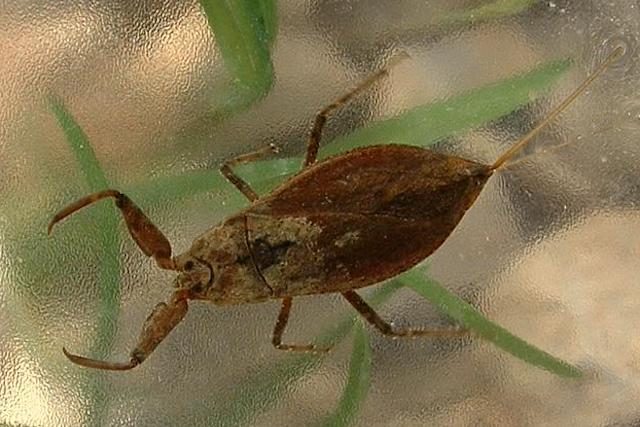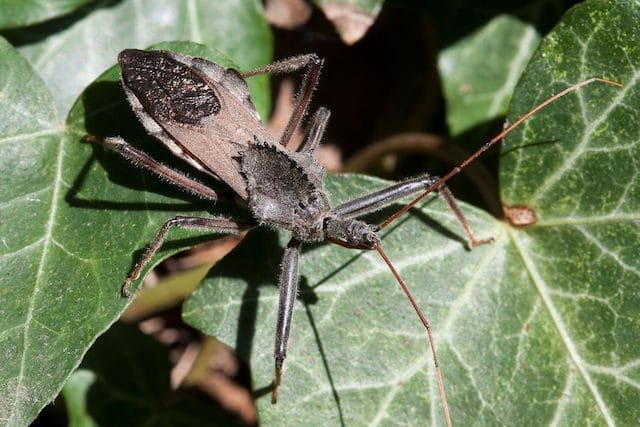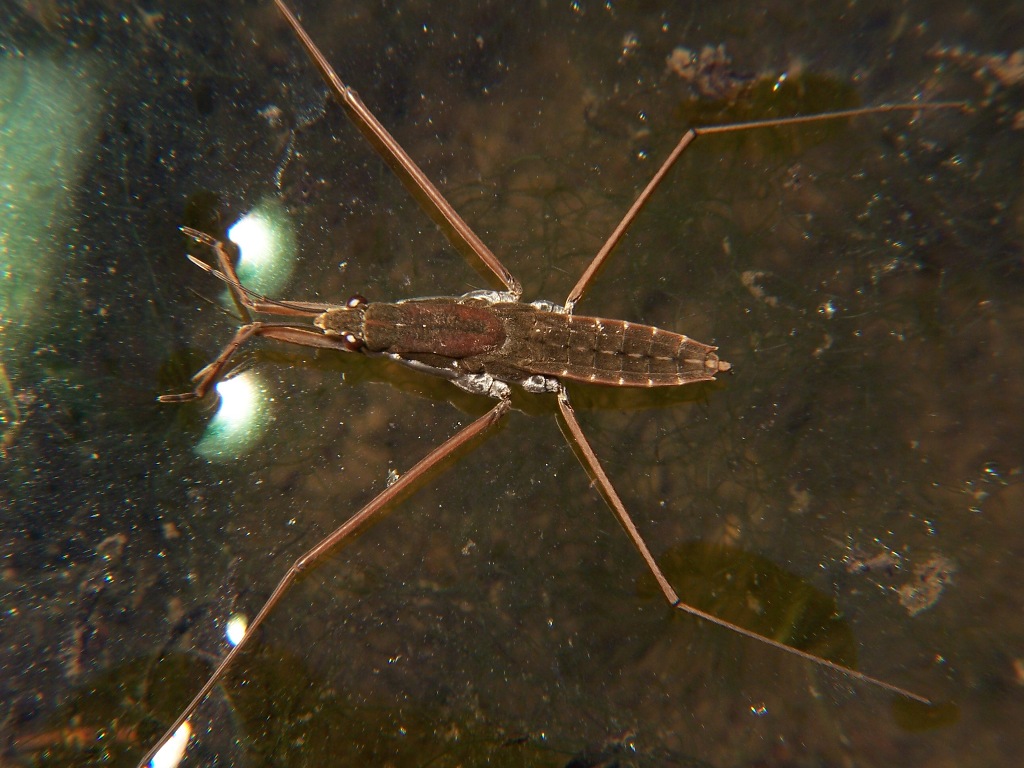Bugs suck. There can be no doubt about the truth of that statement in the minds of many who get bitten by a small natural enemy, but from a purely scientific perspective, it is simply a fact. Bugs are actually a specific taxonomic category of insects, known properly as the true bugs, whose defining trait is that they suck, whether it be plant juice, the liquified remains of enzymatically digested prey, or animal body fluids that is consumed by a bug. In this account, we profile the most outrageous bugs to crawl the Earth, ones guaranteed to astound or horrify the first-time viewer.
10. Kissing Bug

You won’t get a nice kiss from this germy, nasty creature, as its name refers to the fact that this beastly bug, also called a vampire bug, bites humans on the face with frequency, often on sensitive tissue near the eyes or mouth. Known by a variety of descriptive names including Kissing Bug and also the Mexican Bed Bug, the most dangerous species of kissing bugs occur in Central and South America, but at times may head further north. But if a human were to be kissed by the bug, that would be far less serious than the problem that this species presents to us.
Equipped with sucking proboscis parts, the kissing bug disturbingly seeks out human prey by smelling the exhaled carbon dioxide from our mammalian breath before moving in to extract blood from delicate body parts. Kissing bugs really bite, and when they bite humans, it does not only hurt. These strange bugs are the vectors of Chagas disease, a distressing protozoan parasitic infection that can cause many health problems and in some cases, fatality. The cause of the infection is gross. When biting, the bugs frequently defecate, spreading their disease into the wound. Nasty!
9. Giant Water Bug

In nature, trade-offs between sheer size and brute strength versus venomousness are common. But the awful looking creatures known as giant water bugs are both the largest bugs on the planet and highly venomous. Notorious for their massive size and painful biting attacks if disturbed, giant water bugs utilize an incredible combination of stealth, brute strength and envenomation attacks to bring down large prey. Standing out as the largest bugs on the planet, the most massive species of giant water bug may reach 4.75 inches in length. Immobilizing and killing prey with powerful venom, giant water bugs lurk in vegetation in calm waters and inject a chemical mix with a powerful stabbing proboscis that liquifies prey.
And the prey selected by this truly monstrous bug includes fish, amphibians and even baby turtles! Humans may experience nasty injuries and extreme pain for several hours should they tangle with this creature, although the symptoms fade as the toxins dissipate. The bugs are extremely well adapted for aquatic life, yet their flying ability remains an unfortunate reality for those who may have a surprise encounter with a lost individual that is ready to bite. Remarkably, the male water bugs are candidates for being the ultimate father figures. Giant water bug reproduction involves exceptionally involved paternal care, where males carry the sticky eggs on their back before they hatch.
8. Water Scorpion

It lives in the water, it’s huge at up to two inches long, and it’s called a water scorpion. While it looks for all the world like a cross between a stick insect and an actual scorpion adapted to aquatic life, the incredibly creepy water scorpions are in fact just really weird true bugs. While the ability of certain bugs to walk on water is noteworthy, the water scorpions stand out as insects that, being poor swimmers, get around by walking not on top of, but under water. Water scorpions have exaggerated pincers which seize prey, sometimes including small fish. Being loath to swim, water scorpions lurk motionless among aquatic vegetation, aided by the calm waters that they inhabit.
Once potential prey comes close or even brushes against their pincers, the water scorpion lurches forward and seizes the animal in their pincers and holds it fast. Next, the water scorpion’s specially adapted proboscis injects venom, and the liquified insides of the prey are consumed like a soup. Capable of giving humans a sting that is remarkably painful if scooped from the water, water scorpions are air breathing and access oxygen via a long tail tube that further adds to the odd appearance of these big spindly bugs. Dwelling in ponds and lake margins, species of water scorpion are distributed on all continents save for Antarctica.
7. Wheel Bug

An enormous bug with the looks of a seemingly mechanical creation, the wheel bug is a greyish creature with a bizarre cogwheel type structure erupting from its back that gives it the appearance of a monstrous mini-machine. And the damage it can inflict as it inches forward recalls the behavior of a robot programmed to decisively battle against humans and any other creature in its path. Huge for a land-dwelling bug, grey and seemingly weathered in its sombre appearance, the wheel bug has fairly substantial eyes that stare blankly but are dwarfed by the relative size of a sword-like proboscis of substantial proportion that recalls a miniature military sword in shape.
Equipped with an awful beak that injects a stew-making chemical that first paralyzes prey and then liquifies their insides for easy consumption, the wheel bug reaches 1.5 inches in length and occurs in Eastern North America as well as Mexico and Guatemala. Wheel bugs are outrageous predators and mean creatures, which you should never handle. For the wheel bug, mating is no love affair in a significant number of cases, either. A vicious insect species in which the male may be eaten by females after mating, the wheel bug may inflict a nasty wound by stabbing its proboscis into a human, potentially leading to discomfort lasting several months.
6. Flat Bark Bug

While many bugs are aggressive predators, there are also certain bugs whose exact life history and mode of feeding remain something of a mystery. What is not a mystery, however, is why they look as weird and un-buglike as they do. Not totally horrible but more bizarre and, in fact, quite akin to a monster movie premise translated into small scale reality in the world of bugs, the idea of a tree that walks about and acts like an animal, or at least part of a tree, is not so far-fetched, at least not as far as a certain bug is concerned.
When bark, apparently forming part of a standing tree, comes alive and starts to walk, that is a little creepy and also a testament to the innovation of evolution amongst global biodiversity. The Flat Bark Bugs are little known creatures found in arboreal environments around the world, often sheltering underneath openings in the bark of trees in more temperate climates where cold conditions are prevalent. The dietary habits of these bark-come-alive creatures are not well understood, although the majority of species are believed to be fungus eaters. In these cases, the sucking apparatus of these bugs would be used to probe into their selected food items.
5. Sea Skaters

We all know that insects did not reach the ocean and are not represented in the Earth’s marine ecosystems, correct? Actually, there are sea bugs that inhabit the world’s oceans and they consist of several species of true bugs in the genus known as Halobates or sea skaters. When the nymphs of these exclusive seafaring insect species mature, they form a small but impressive hunter that does not prowl under the waves, but actually stands astride the waves as it hunts. And while sea skaters are accomplished hunters, they are also a food source for seabirds, forming a dietary component of scientific interest in certain marine bird populations. Remarkably, sea skaters do not drown if swamped by waves, for hairs that have been compared to a life jacket hold air and allow the bugs to surface unharmed.
Despite the rough conditions, salt spray, and turbulence of their home environment compared to the still waters utilized by a vast number of more typical bug species, the sea skaters thrive in their adopted environment in a stark testament to the power of adaptation. More than 40 species of this strange offshoot of the water strider family exist worldwide, and of these, 5 are truly oceangoing. While small, these creatures are in fact vicious predators for their size, weathering the brutal conditions of the open marine seascape and plundering hapless plankton from the waves with the help of a venom bearing proboscis. Represented on Earth as far back as 45 million years according to fossil records, the sea skaters lay their eggs on tiny debris pieces floating in the ocean.
4. Ant Mimic Assassin Bug

An accomplished hunter and a true master of disguise in a bid for self-preservation, the Ant Mimic Assassin Bug Myrmecoris gracilis itself avoids larger predators by resembling an unpalatable ant. Ants are unappealing to many predators unable to handle formic acid, and are readily recognizable by their narrow waist. The Ant Mimic Assassin Bug has a broad body and would look like an edible bug without its ingenious disguise. Near the insect’s waist are two large white patches, which when the animal is viewed, do not appear to be part of the outline of the otherwise dark insect.
Looking like a narrow-waisted and disgustingly acidic ant, the mimic can roam freely while appearing unappetizing to predators. And that allows the ant mimic to focus on the hunt. This bug is armed with a flesh dissolving mix of chemicals that are injected through a wicked looking proboscis. The Ant Mimic Assassin Bug lurks around places where insect prey are likely to congregate. Favoring soft-bodied aphids as prey, the defensively camouflaged predator switches modes upon discovering a target. The wandering “ant” lunges forward and stabs its victim with the proboscis, immobilizing and dissolving the prey, turning it into an easy meal for the Ant Mimic Assassin Bug.
3. Stink Bug
While true bugs may be notorious for the members of their ranks that stab and liquify animal prey, herbivorous bugs stab, suck, and wilt plants in their own dogged attempts to gain nourishment. But such behavior makes them a “sitting bug” for predators. The stink bugs have resolved this evolutionary dilemma of suck or be sucked to death by becoming masters of sneaky chemical warfare. Stink bugs resemble plate-like, land-going water bugs, or at least a steamrolled beetle with their flat shields, but their true armor is a horrendously noxious chemical concoction that oozes thickly and deters predators.
The bad taste may linger long enough to cement in the memory of a predator “do not even try.” The smell may also hold for a time, while the chemical itself can irritate sensitive tissues and make for a hard hunting lesson. Particularly concerning in North America, the Brown Marmorated Stink Bug, an East Asian species has become highly prevalent in growing parts of North America, arriving as a hitchhiker on transported goods and stuffs. Not only is this bug a pest, what’s worse is that predators do not curb its numbers as it stinks and tastes disgusting thanks to the toxic chemical soup it can dish out at a moment’s notice.
2. Common Water Strider

Spreading the weight of its elongated, boat-shaped body across four of its six legs, which have been exaggerated in proportion to the rest of its body, a sizable but slender master predator stalks across the surface of rivers, ponds and lakes, walking on water. Brown in color, with a longish body and wire-thin legs, the Common Water Strider is an opportunistic sucking predator that acts in a typical manner of true bugs with a piercing proboscis. Superficially resembling a cranefly, the ideally evolved creatures may look unremarkable at first glance, except that they can literally walk on water to reach their victims. The smaller front legs are deployed to seize small prey.
Then, the ghastly biting behavior of this species follows as chemicals are injected through the beak to liqufy the insides of the prey before consumption. While most animals would drown, the water strider harnesses the power of surface tension to balance, walk and simply stand on water without sinking. but walking on water gives it numerous nicknames, not surprisingly including “Jesus bug.” While mating, the male rides on the back of the female. While delicate looking, these agile bugs can move like lightning, rushing forward at nearly 5 feet per second when necessary.
1. Common Backswimmer

The sight of a person in a rowboat sweeping oars in the water is not a motion that was invented by humans. Select true bugs have mastered this motion independently and eons before human beings developed this mode of transportation. Common Backswimmers, also known as Greater Water Boatmen, are fearsome, highly venomous bugs that float up to the water’s surface and then hang just below, scanning for prey. Upon sighting a victim, which may range from another insect to a minnow or juvenile amphibian, the backswimmers burst into pursuit mode, propelling themselves at incredible speeds by rowing boat-fashion through the water column, often down the bottom before violently plunging their single, fang-like beak into their prey.
The backswimmer is very buoyant, but the power of its legs propels it easily despite its natural tendency to float to the surface. After a lightning fast rush, the backswimmer can effortlessly return to the surface to hunt again. Liquifying enzymes are then injected before the meal is clutched in the bug’s legs and consumed. If a human should even touch a backswimmer, a nasty bite that feels like a hypodermic injection of chemical solvents is a likely result, causing true misery to ruin a nice time at the lake, as experienced by the author.